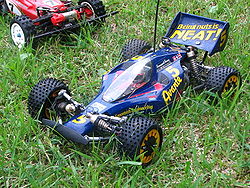
Tamiya Avante
Encyclopedia

Although Tamiya had contributed to the market for 1/10-scale electric offroad, the company had fallen significantly behind in the development of serious race cars such as those from manufacturers Associated Electrics
Associated Electrics
The acronym TC5 redirects here. For the American rock band, see The Click Five.Associated Electrics, Incorporated of Lake Forest, California is one of the world's leading manufacturers of radio controlled cars, trucks and accessories...
, Kyosho
Kyosho
is a model car company based in Tokyo, Japan. The brand operates internationally under the name KYOSHO. The company's main office is located in Chiyoda, Tokyo, and the production headquarters are located in Atsugi, Kanagawa....
, Team Losi
Team Losi
Team Losi is a USA based radio-controlled car manufacturer founded by Gil Losi in the late-1980s and is owned by Horizon Hobby.- History of Team Losi :...
, and Yokomo
Yokomo
is a Japanese company from Adachi, Tokyo that specialize in radio-controlled cars, it was one of the first manufacturers in Japan to build RC cars and it also invented the RTR cars, but most notable of all is their long-running "Dog Fighter" series of radio controlled buggies, mainly through its...
.
Starting with a new and somewhat radical design, Tamiya chose to create the Avante from aluminum and fibre-reinforced plastic
Fibre-reinforced plastic
Fibre-reinforced plastic is a composite material made of a polymer matrix reinforced with fibres. The fibres are usually fibreglass, carbon, or aramid, while the polymer is usually an epoxy, vinylester or polyester thermosetting plastic...
composite as opposed to the ABS
Acrylonitrile butadiene styrene
Acrylonitrile butadiene styrene is a common thermoplastic. Its melting point is approximately 105 °C ....
resin used in their previous offerings. It was also intended to be more tunable and adjustable than any other car on the market with its combination of a stiff composite
Composite material
Composite materials, often shortened to composites or called composition materials, are engineered or naturally occurring materials made from two or more constituent materials with significantly different physical or chemical properties which remain separate and distinct at the macroscopic or...
chassis, oversized and tunable aluminum shocks and adjustable upper turnbuckles which allowed for changes in toe
Toe (automotive)
In automotive engineering, toe, also known as tracking, is the symmetric angle that each wheel makes with the longitudinal axis of the vehicle, as a function of static geometry, and kinematic and compliant effects. This can be contrasted with steer, which is the antisymmetric angle, i.e. both...
and caster
Caster angle
thumb|250px|θ is the caster angle, the red line is the pivot line, and the grey area is the tire.Caster angle or castor angle is the angular displacement from the vertical axis of the suspension of a steered wheel in a car, bicycle or other vehicle, measured in the longitudinal direction...
.
Despite the seemingly winning combination of stiffness plus near-infinite adjustability, the Avante suffered more than its share of problems. Aluminum parts were easily broken, the front suspension had a tendency to bottom out on jumps and even the handling was subpar when compared to its competition. In a model with a retail price of US$300, these faults were not easily overlooked by racers and sales suffered badly.
Overall, the Avante did advance the technology of four-wheel-drive offroad racing with its innovative use of exotic materials, ease of assembly and groundbreaking design features such as its motor mounted amidships and parallel to the driveshaft, its use of foam inserts in the tires to increase stiffness and ball differentials, all standard fare on today's models. The Avante's basic design was used in future Tamiya offerings less the exotic materials.
Today, the Avante is a highly sought-after collector's item, with new-in-box examples demanding more money than many other collectible Tamiya cars of the period.
A competitive new sport/racing model, the Avante Mk. II, is based on Tamiya's DF-03 monocoque
Monocoque
Monocoque is a construction technique that supports structural load by using an object's external skin, as opposed to using an internal frame or truss that is then covered with a non-load-bearing skin or coachwork...
chassis topped with a Lexan
Lexan
Lexan is a registered trademark for SABIC Innovative Plastics' brand of polycarbonate resin thermoplastic. Polycarbonate polymer is produced by reacting bisphenol A with carbonyl dichloride, also known as phosgene. Lexan is the brand name for polycarbonate sheet and resin in a wide range of grades...
body evoking the original car.
Specifications
- Scale: 1/10
- Chassis construction: Two-piece FRPFibre-reinforced plasticFibre-reinforced plastic is a composite material made of a polymer matrix reinforced with fibres. The fibres are usually fibreglass, carbon, or aramid, while the polymer is usually an epoxy, vinylester or polyester thermosetting plastic...
composite "sandwich" - Transmission: Four-wheel-drive via a solid shaft, Uniqe 6-gear differentials
- Suspension: Four-wheel independent
- Shock absorbers: Aluminum, oil-filled, fully adjustable
- Motor: Mabuchi RX-540VZ "Technigold" (optional in some kits, especially in North America)
- Tires: Rubber pin spike off-road tires with foam inserts front and rear
- Original Tamiya catalog number: 58072
External links and reference
- {http://www.robobugs.net/galleries/favorites/tamiya-avante-history-58072.htm]
- Avante Mk. II page in English at Tamiya.com

